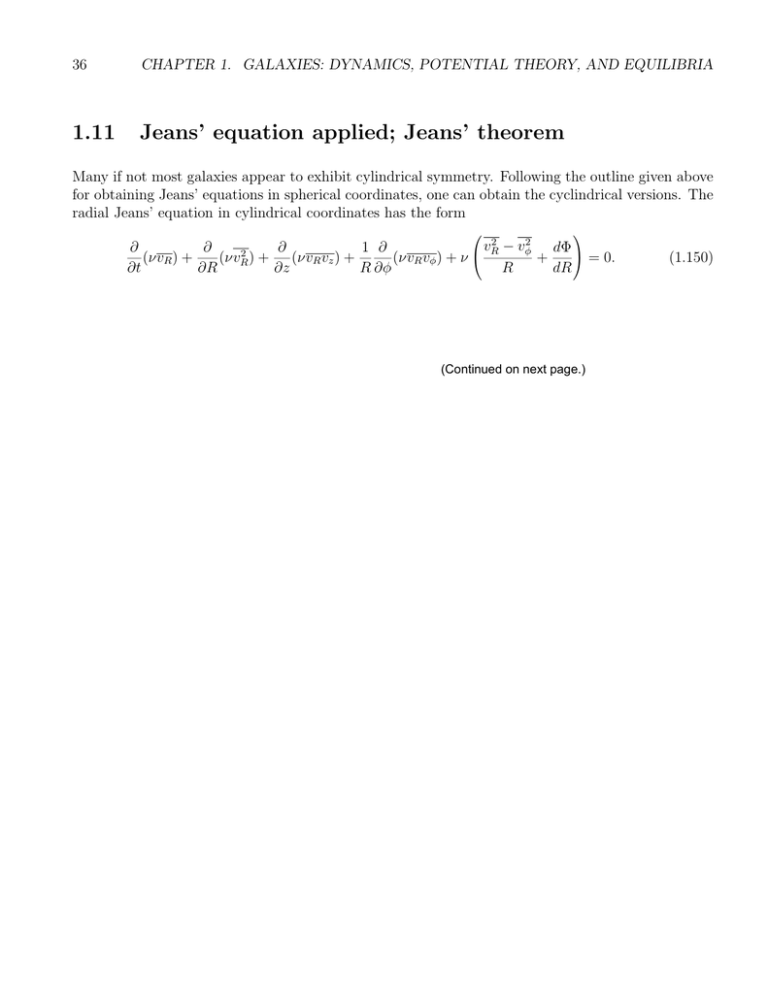1.11 Jeans’ equation applied; Jeans’ ...
advertisement

36 CHAPTER 1. GALAXIES: DYNAMICS, POTENTIAL THEORY, AND EQUILIBRIA 1.11 Jeans’ equation applied; Jeans’ theorem Many if not most galaxies appear to exhibit cylindrical symmetry. Following the outline given above for obtaining Jeans’ equations in spherical coordinates, one can obtain the cyclindrical versions. The radial Jeans’ equation in cylindrical coordinates has the form ⎩ ⎜ vR2 − vθ2 dΛ � σ σ σ 1 σ 2 ⎪ (�vR ) + + (�vR ) + (�vR vz ) + (�vR vθ ) + � = 0. σt σR σz R σθ R dR (Continued on next page.) (1.150) 37 1.11. JEANS’ EQUATION APPLIED; JEANS’ THEOREM 1.59 2 Figure 1.24: Circular velocity(normalized by the one dimensional velocity dispersion) as a function of radius in an isothermal sphere. The peak value occurs at rrc � 3 v/σ 3 r/rc In the steady state the average azimuthal velocity vθ does not in general equal the circular velocity at that radius vc (R). The difference between the two is called the asymmetric drift, va ≥ v θ − v c , (1.151) averaged over a volume element at a fixed position in space. Recall from the virial theorem [eqns. (1.38) and (1.40)] the relation √v 2 ⇔orbit = √vc2 ⇔orbit , (1.152) 2 = v R2 and where √v 2 ⇔ = √vθ2 + vR2 + vz2 ⇔. For a steady state vR = vz = 0. We then can substitute εRR 2 εRz = vR vz into the radial Jeans equation (1.150) and find 2 2va vc = εRR � � 2 2 2 εθθ σ ln(�ε RR ) R σ(εRz ) − 1 − − . 2 2 εRR σ ln R εRR σz (1.153) To first order, this gives an expression for the asymmetric drift at a fixed position, 2 va εRR � 2 vc vc . (1.154) Observations of nearby stars in the Milky Way show a correlation between the amplitude of the asymmetric drift and the stellar type, which is in turn correlated with stellar ages. Older stars (G,K,M class) tend to have higher velocity dispersions, due to the fact that they have had a longer time to get “kicked around” by scattering with nearby stars. The second moment of the CBE in cylindrical coordinates gives the relationship between the Oort constants and the epicyclic freqency cited without proof in Section (1.7) 2 εθθ η2o −B = = , 2 2 ε RR 4�o A−B where A and B are the Oort constants defined in equations (1.114) and (1.115). 1.11.1 Jeans’ theorem Jeans’ Theorem is so simple that one at first doubts whether it has any content: (1.155) 38 CHAPTER 1. GALAXIES: DYNAMICS, POTENTIAL THEORY, AND EQUILIBRIA • Any steady-state solution of the collisionless Boltzmann equation depends on the (6-dimensional) phase-space coordinates only through the (3) isolating integrals of motion in the galactic po­ tential. • Any function of the the integrals of motion yields a steady-state solution of the collisionless Boltzmann equation. To prove the second part of Jeans’ Theorem, consider an integral of the motion I(ξx, ξv), where the total time derivative of I is zero, d ξ · dξx + σI · dξv = 0 . I[ξx(t), ξv(t)] = �I dt dt σξv dt (1.156) But since dξv/dt = −�Λ, then equation (1.156) is precisely the Collisionless Boltzmann equa­ tion (1.119) with I representing a solution without explicit time dependence. Now take a general function of the integrals of motion g(I1 , ..., In ). The time derivative of g is given by n � d σg dIj = 0, g= dt dt j=1 σIj ���� (1.157) =0 so we find that g is also an integral of the motion and is therefore also a solution of the CBE. The first part of Jeans’ Theorem is evident from the fact that the distribution function f (ξx, ξv) is itself an integral of the motion. Also known as Liouville’s Theorem, this is the same as saying that the phase space density is conserved along the orbit. Here we present a few practical applications of Jeans’ Theorem. For the case of spherical symmetry and an isotropic velocity dispersion, the density is a function only of radius r and the distribution function depends only on total energy: δ = δ(r) ∝ f = f (E). (1.158) For a spherical system with an anisotropic velocity dispersion tensor, the distribution function will depend on energy and total angular momentum: δ(r), �(r) ∝ f (E, L2 ). (1.159) If the potential is axisymmetric, the z-component of the angular momentum will be conserved along a given orbit, making Lz an isolating integral of motion. Distribution functions of the form f (E, Lz ) will give solutions to the CBE. Integrating over the distribution function one can calculate spatial densities δ(ξx) for spheroids or surface densities Ψ(ξx) for disks and (in both cases) mean azimuthal velocities vθ (ξx). Up until this point we have been rather schematic and qualitative. How does one actually calculate the distribution function for an arbitrary potential? Consider the isotropic, spherically symmetric case where f = f (E). Following Binney and Tremaine, we define the relative potential Γ and relative energy π as Γ = −Λ + Λo (1.160) 39 1.11. JEANS’ EQUATION APPLIED; JEANS’ THEOREM and 1 π = −E + Λo = Γ − mv 2 . 2 (1.161) Then the number density in space can be calculated from the distribution function by integrating over all of velocity space �(ξx) = � vmax 0 3 f (ξx, ξv)d ξv = 4ψ � ∗ 2� 0 1 v 2 f (Γ − v 2 )dv, 2 (1.162) ∞ where we have used the escape velocity ve = 2Γ as the upper limit in the velocity space integral. Performing a change of variables dπ = vdv gives �= � � 0 � f (π) 2(Γ − π)dπ. (1.163) Differentiating with respect to Γ gives the following � � dδ f (π) � dπ. = 4ψM dΓ 0 2(Γ − π) (1.164) Applied mathematicians may recognize this as an Abel integral equation, which can be inverted to give the distribution function as a function of density, 1 d � ν dδ dΓ ∞ f (π) = 2 ∞ . ψ 8M dπ 0 dΓ π − Γ (1.165) We might, for example, use the above method to compute the distribution function for an isother­ mal sphere. But instead we make an inspired guess for a distribution function, � (Γ − 21 v 2 ) ω f (π) = ∞ exp − ε2 ε 2ψ � . (1.166) Integrating this over velocity space we get δ = ω exp ⎞ Γ ε2 ⎢ , (1.167) and see where it takes us. Solving this for the relative potential Γ and then invoking Poisson’s equation we find �2 Γ = � 2 ⎡ 1 d 2d ε 2 d r2 dδ Γ r Γ = −4ψGδ = = 4ψω exp 2 2 2 r dr dr r dr δ dr ε ⎞ ⎢ , (1.168) ε Letting κ2 = 4�Gσ and ∂ = r/κ we recover the equation for the isothermal sphere, equation (1.148) – our inspired guess of f (π) has indeed given us the isothermal sphere.



